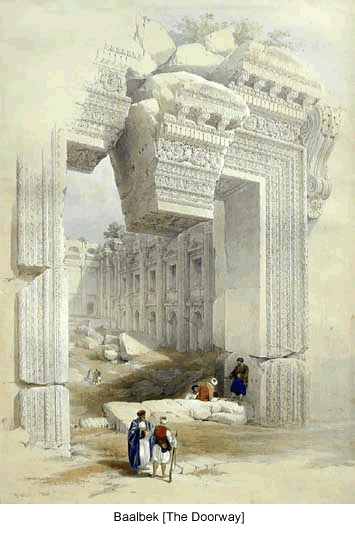



Roberts' intention was to travel north through Lebanon to the famous ruins of Baalbec, and thence eastward to Damascus. He was by now tired and running low on provisions, but he pressed on and arrived at Baalbec on May 2. For the first time during his long journey, he became ill. Despite his weakness, Roberts worked for four days, sketching the magnificent Roman temple complex, which he found as impressive as anything he had seen along the Nile. (View the lithographs of Baalbec.)
His plans were now complicated by yet another factor. Civil unrest was reportedly brewing in Damascus, and travel there would be dangerous, if not impossible. Roberts reluctantly decided to end his journey at Baalbec. From there he traveled to Beirut, where he booked passage by steamer back to Alexandria. After a brief reunion there with his traveling companions Kinnear and Robertson, he returned to London on July 21, 1839, having been eleven months absent.
Roberts now set about the publication of his works, which would ultimately require nine years to complete - but that, as they say, is another story. (For a more detailed description of this publication history and the prints themselves, see About Roberts Prints.)
The exhibition of his paintings and drawings of the journey, on which the lithographs would be based, assured Roberts' reputation. In 1841 he was elected to the Royal Academy in London, thenceforth being known as "David Roberts, R.A." (as his signature appears on the published lithographs.) In the coming years he would continue his lifelong habit of travel, mostly within Europe, but none of his later works would convey the power and mystery of his drawings and paintings of Egypt and the Holy Land. Times were changing and the new process of photography was supplanting the works of the "travel artists". Nonetheless, Roberts continued to produce works of art for the next 25 years, including a number of commissions for Queen Victoria. He was in the midst of creating a painting of St. Paul's Cathedral in London, when on November 25, 1864, he died of a stroke at the age of 68. Roberts would be pleased to know of the enduring popularity of his lithographs - his dedication to their publication in large, high quality format has helped ensure their preservation and continued display throughout the world. Among nineteenth century travel prints they stand head and shoulders above all others, both as to their value and, in the view of many, their artistic merit.


